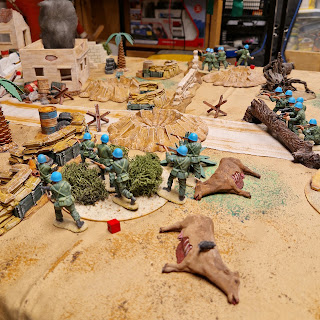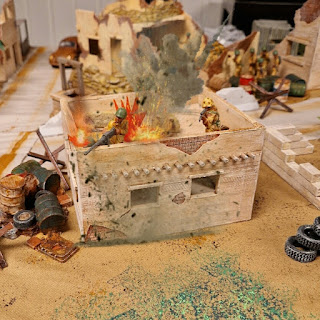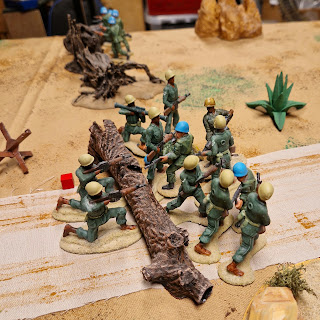The last play-test of my own home-brewed house rules did not go so well and smooth as I hoped for. Was this test representative for how the rules would work? There was only one thing to do, and that was to use them for another game to see. I sent my miniatures back to Lumbaya again since I hadn't put the setup away yet and have a replay. The outcome was pretty much the same; long playing time and low casualties rates. No new battle report for that game as it just turned out to be a replay of the last.
The rules needed some adjustments to make them more playable in a reasonable amount of time. First I adjusted the D6-value to score hits from 4+ on short ranges and 5+ on long ranges, to 3+ on short ranges and 4+ on long ranges. There are so many other factors that have influence on the hit-probability within these rules anyway.
Secondly I adjusted the probability from 33% to 50% that unsaved hits would cause a 'kill', even thou I vaguely remember that I've read somewhere that during WWII about only 1/3 of hits were lethal. Besides, a saved hit is still a hit, so I suppose the 'kill probability' for hits are still closer to 33%.
Thirdly I increased the 'hypothetical' Rate of Fire, damage potential and the hit probability on heavy weapons by adding another D6 for firing LMGs, HMGs and Mortars as these kind of weapons simply does more damage.
The (updated) rules
The test
Now the rules needed to be tested again, so I went for the same, familiar by many now, game, setup and scenario as for the other earlier games in this 'series'. I repeat it here again if you haven't read my earlier reviews yet:
The scenario
I've placed this skirmish to the United Nations largest mission in both scale and operational scope during the Congo Crisis 1960-65, when UN troops 'peacekeeping' was more offensive 'peace enforcement' with force.
Situation:
This skirmish is finding place in fictional place of Lumbaya in the early January of 1963, when the UN during operation '
Grand Slam' are turning their attention to the remaining Katangese strongholds in Southern Katanga after after securing the Katangese capitol of Élisabethville.
Place:
Lumbaya is a very small village located 80km south west of Élisabethville, and are made into a stronghold by a small platoon of Katangese Gendarmes. The village is one of several strongholds in the area to trying to hold the UN off while trying to keep the self-proclaimed president Tshombe by power of the self-proclaimed Katanga state.
Forces:
Forces:
- Katangese:
- 2 rifle-squads each of 10 soldiers, a LMG and and a bazooka/flame thrower. Each squad can operate as 2 fireteams independently.
- 1 HMG-detachment of 3 soldiers
- 1 sniper
- HQ-section with platoon-leader and 2 medics
- After turn 12: A QRF consisting of 1 truck with a HMG and a section of 10 'veterans' with a LMG and a bazooka arrives from the next village. Only if Lumbaya is still held by Katangese forces.
- UN:
- 1 Platoon of 3 rifle-squads each of 8 soldiers and a LMG. The squads can operate independently.
- 1 Light mortar-detachment of 2 soldiers and an observer
- 1 bazooka-detachment of 3 soldiers
- HQ-section with platoon-leader
- 1 Jeep with HMG and 2 soldiers.
Mission:
- Katangese: To hold the strongpoint of Lumbaya. Can request QRF-support as mentioned in the force-section from turn 12 if still holding whole or part of the strongpoint.
- UN: To take and hold the strongpoint of Lumbya, preferably within 12 turns, and take control on as many Katangese gendarms located there as possible.
AAR
Time: 2 hours and 20 minutes
Turns: 11
Result: UN withdrawal
Early in the UN offensive the Katangese support team came under heavy suppressive fire, and got pinned for several turns. The sniper was very effective though
This made way for an UN advance, but the advancing UN squads met suppressive fire and got pinned for several turns before they could reach sufficient cover.
Meanwhile the Katangese medics did an heroic effort to try to get the crew back in action, but in the end the UN forces finally managed to eliminate the Katangese support weapons and their sniper by a direct hit.
...- but too late. The UN squads had suffered several casualties after being pinned without sufficient covers for so many turns, that they had to withdraw by the rules and by sense. The Katangese Gendarmerie managed to hold their strongpoint for now.
Pros
- The adjustments as described in the start of this post gave a slightly higher rate of casualties in relation to fire, and really made these rules more playable in a reasonable amount of time.
Cons
- These rules really differs between defending and attacking forces regarding hit-probability; It gives units in fortified and defensive positions, and therefore don't have to move around in the line of fire, a huge advantage over advancing units, which have to use movement and cover to better their odds.
Conclusion
With almost 2 equally sized forces in this game these rules gave the fortified defenders such a big advantage over the attackers that the attackers almost didn't have a chance. Really just as in the real life with the 3:1 rule of combat; Traditionally it is accepted that a defending force has a 3:1 advantage over an attacker. In other words, a defending force can hold off three times its own number of attacker.
Therefor I think it would be reasonable to try these rules again with a smaller defending unit against a larger attacking force. Ideally 3:1 proportion. Since the defending Katangese forces also had several casualties in this game and also lost their HMG and sniper, they are so reduced and weakened that I would like to see whats happen if they meets another full strength UN platoon again.
So I let the UN Company Commander throw in his last platoon in a desperate attempt to take and hold the Katangese Strongpoint of Lumbaya...


























































.jpg)





